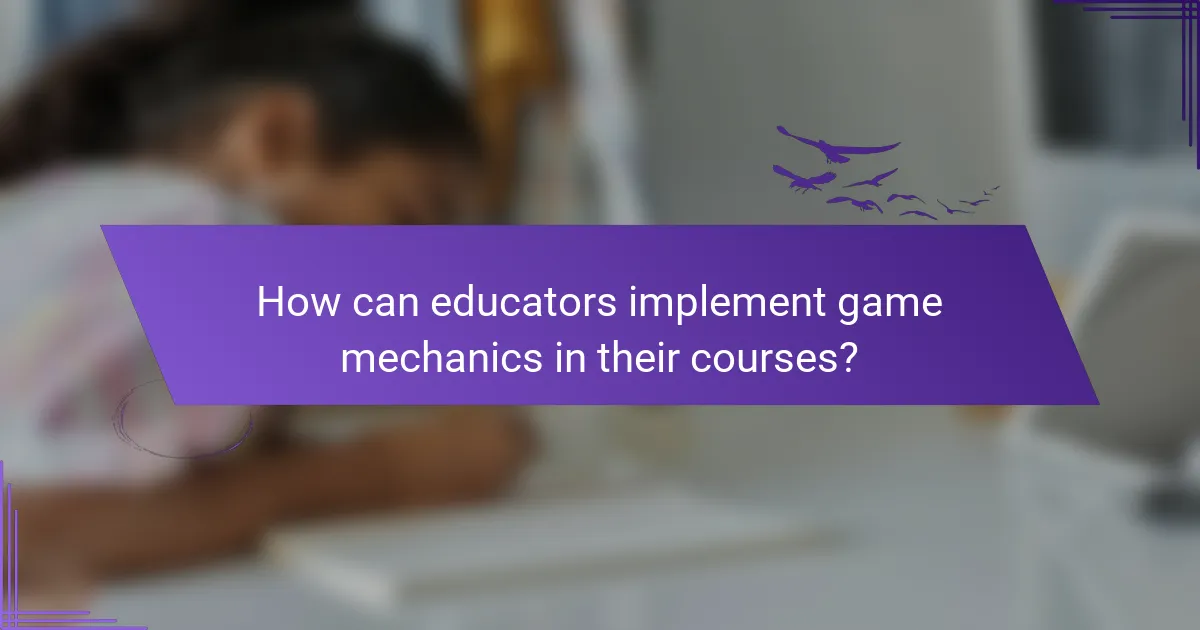Game mechanics play a crucial role in enhancing online learning platforms by transforming traditional educational experiences into interactive and engaging journeys. By integrating elements like rewards, challenges, and competition, these platforms foster increased user engagement and improve knowledge retention. This comparative analysis explores how various learning platforms utilize game mechanics to motivate learners and create enjoyable educational environments.

How do game mechanics enhance online learning platforms?
Game mechanics enhance online learning platforms by making the learning experience more interactive and enjoyable. By incorporating elements such as rewards, challenges, and competition, these platforms can significantly boost user engagement and knowledge retention.
Increased engagement through rewards
Rewards in online learning platforms can take various forms, such as points, badges, or certificates. These incentives encourage learners to complete tasks and participate actively, leading to higher engagement levels. For example, a platform might offer a badge for completing a module, motivating users to progress through the content.
To maximize the effectiveness of rewards, it’s essential to ensure they are meaningful and aligned with learners’ goals. Avoid overwhelming users with too many rewards; instead, focus on a few significant milestones that provide a sense of achievement.
Improved retention via interactive challenges
Interactive challenges, such as quizzes and simulations, help reinforce learning by requiring users to apply their knowledge actively. This hands-on approach can enhance memory retention compared to passive learning methods. For instance, a platform might use scenario-based learning where users must solve problems in a simulated environment.
When designing challenges, aim for a balance between difficulty and accessibility. Challenges that are too easy may not engage learners, while those that are too difficult can lead to frustration. Incorporating adaptive learning techniques can help tailor challenges to individual skill levels.
Motivation through competition
Competition can be a powerful motivator in online learning platforms, fostering a sense of community and encouraging users to strive for improvement. Leaderboards, contests, and peer comparisons can create a dynamic environment where learners feel driven to excel. For example, a platform might display top performers in a course, prompting others to increase their efforts.
However, it’s crucial to manage competition carefully. While some learners thrive in competitive settings, others may feel discouraged. Providing options for collaboration alongside competition can help cater to diverse learning preferences and maintain a positive atmosphere.

Which learning platforms utilize game mechanics effectively?
Several learning platforms effectively incorporate game mechanics to enhance user engagement and motivation. These platforms use elements like quizzes, rewards, and badges to create an interactive and enjoyable learning experience.
Kahoot! for interactive quizzes
Kahoot! leverages game mechanics by allowing users to create and participate in interactive quizzes that promote competition and collaboration. Users can join games using a code, answering questions in real-time, which fosters a lively learning environment.
To maximize engagement, educators can customize quizzes with images and videos, making the content more appealing. The platform also provides instant feedback, which helps learners understand their performance and areas for improvement.
Duolingo for language learning
Duolingo employs game mechanics by integrating levels, rewards, and streaks into its language learning process. Users earn points and unlock new levels as they complete lessons, creating a sense of achievement and progress.
The app encourages daily practice through streaks, motivating users to return regularly. Additionally, Duolingo includes challenges and leaderboards, fostering a competitive spirit among learners, which can enhance retention and fluency.
Coursera for course completion badges
Coursera utilizes game mechanics by offering badges and certificates upon course completion, which serve as tangible rewards for learners. These badges can be shared on professional networks, adding value to the learner’s resume.
To effectively use this feature, learners should focus on completing courses that align with their career goals, as recognized credentials can significantly enhance job prospects. However, it’s important to choose courses wisely, as not all badges carry the same weight in the job market.

What are the key game mechanics in educational contexts?
Key game mechanics in educational contexts include elements that enhance engagement and motivation, such as points, levels, and social comparisons. These mechanics help learners track their progress, compete with peers, and stay motivated throughout their educational journey.
Points and scoring systems
Points and scoring systems provide a quantifiable measure of a learner’s achievements and progress. By assigning points for completing tasks, quizzes, or challenges, educators can create a clear incentive structure that encourages participation and effort.
For example, a platform might award 10 points for completing a module and an additional 5 points for achieving a high score on a quiz. This system not only motivates learners but also allows them to see their cumulative progress over time.
Levels and progression
Levels and progression systems create a sense of advancement and accomplishment. As learners complete tasks or accumulate points, they can unlock new levels, which often correspond to more challenging content or new skills.
For instance, a language learning app might have levels ranging from beginner to advanced, with each level requiring a certain number of points to unlock. This structure helps learners set goals and provides a clear pathway for skill development.
Leaderboards for social comparison
Leaderboards facilitate social comparison by displaying learners’ rankings based on their points or achievements. This mechanic can foster a sense of competition and community among users, motivating them to improve their performance.
However, it’s important to consider the potential downsides; not all learners respond positively to competition. Educators should balance leaderboard visibility with encouragement and support, ensuring that it enhances motivation without discouraging those who may struggle.

How do different demographics respond to game mechanics?
Different demographics exhibit distinct preferences for game mechanics, influencing their engagement and learning outcomes. Understanding these variations can help educators and developers tailor their platforms to better meet the needs of their users.
Millennials prefer competitive elements
Millennials often thrive in environments that incorporate competitive elements, such as leaderboards and achievement badges. These features can stimulate motivation and encourage participation, making learning more engaging.
In practice, platforms targeting Millennials might include challenges that allow users to compete against peers or track their progress against others. This competitive spirit can drive users to invest more time and effort into their learning experiences.
Gen Z values instant feedback
Gen Z learners place a high value on instant feedback, which helps them quickly understand their performance and areas for improvement. This demographic tends to prefer mechanics that provide immediate results, such as quizzes with instant grading or interactive simulations that offer real-time responses.
To cater to Gen Z, educational platforms should implement features that allow for quick assessments and feedback loops. For example, incorporating gamified quizzes that provide instant scores can enhance engagement and facilitate learning retention.

What criteria should be used to evaluate game mechanics in learning?
To evaluate game mechanics in learning platforms, consider criteria such as effectiveness in knowledge retention and user engagement metrics. These factors help determine how well the game elements support educational goals and maintain learner interest.
Effectiveness in knowledge retention
Knowledge retention measures how well learners can recall and apply information after engaging with game mechanics. Effective game mechanics often incorporate spaced repetition and retrieval practice, which can significantly enhance memory retention over time.
For instance, a learning platform that uses quizzes interspersed with gameplay can reinforce concepts, leading to better long-term retention. Aim for a balance where learners revisit material periodically, ideally within days or weeks, to solidify their understanding.
User engagement metrics
User engagement metrics assess how actively learners interact with the game elements. Key indicators include session duration, frequency of play, and completion rates of tasks or levels. High engagement often correlates with improved learning outcomes.
To enhance engagement, consider implementing rewards systems, such as badges or points, which can motivate learners to participate more fully. Monitoring these metrics regularly can help identify areas for improvement, ensuring that the game mechanics remain appealing and effective.

How can educators implement game mechanics in their courses?
Educators can implement game mechanics in their courses by incorporating elements like points, badges, and leaderboards to enhance student engagement and motivation. These strategies encourage active participation and can lead to improved learning outcomes.
Integrating quizzes and challenges
Quizzes and challenges can serve as effective game mechanics by providing immediate feedback and reinforcing knowledge. Educators should consider using a variety of formats, such as multiple-choice questions, fill-in-the-blank exercises, or timed challenges to cater to different learning styles.
To maximize engagement, quizzes can be structured as competitions where students earn points for correct answers. This approach not only motivates learners but also fosters a sense of community through friendly rivalry.
When designing quizzes, aim for a balance between difficulty and accessibility. Start with easier questions to build confidence, then gradually increase the challenge to maintain interest without overwhelming students.
Using simulations for real-world applications
Simulations provide immersive experiences that allow students to apply theoretical knowledge in practical scenarios. By mimicking real-world situations, educators can enhance critical thinking and problem-solving skills among learners.
Consider using simulations that reflect industry standards or practices relevant to the subject matter. For example, business courses might include market simulations, while science classes could use virtual labs to conduct experiments.
To ensure effectiveness, educators should provide clear objectives and debriefing sessions after simulations. This helps students reflect on their experiences and solidify their understanding of the concepts applied during the activity.


